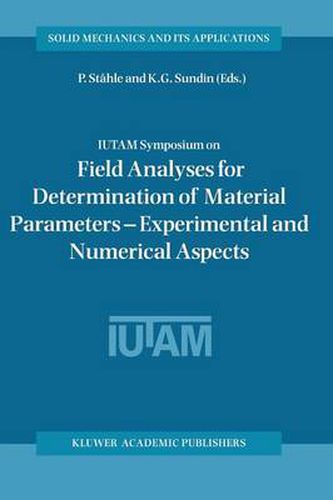Readings Newsletter
Become a Readings Member to make your shopping experience even easier.
Sign in or sign up for free!
You’re not far away from qualifying for FREE standard shipping within Australia
You’ve qualified for FREE standard shipping within Australia
The cart is loading…






This title is printed to order. This book may have been self-published. If so, we cannot guarantee the quality of the content. In the main most books will have gone through the editing process however some may not. We therefore suggest that you be aware of this before ordering this book. If in doubt check either the author or publisher’s details as we are unable to accept any returns unless they are faulty. Please contact us if you have any questions.
The symposiumwas motivatedby theincreasing need for modelling of material behaviourundervarious mechan icalconditions. This need is driven by the evolut ion ofcomputer capac ityand the resulting ability for engineers and scien tiststo address complexproblems . Reliable models formaterialbehaviour, including accurate numericalvalues of parameters ,are necessary for a continued beneficial development ofthe computational side of solid mechanics .High rate plasticity ,thermally assisted creep and phasetransformationsare only a fewexamplesof areas where more accurate modelsare needed. Experiments are necessary for the establishment ofmodels and parameters , and modified versionsof conventional test methods can make important contributions . Also modern optical methodsoffer a highpotentialfor futureexperimental development. Numerical simulations ofexperiments and so-called inverse modelling arealso frequentlyused techniques. The aim of the symposium was to bring together researchers with an interest in the areaofexperimental and computational aspects ofmaterial modelling for exchange and discussionofpromising methodsandresults. Abisko,a national park in the Swedish mountain district about 200 km north of the arctic circle and about one hourve dri from the airport ofKiruna,was chosen for the symposium. The tourist hotel in the park , overlookinga beautiful lake , offered a suitablevenue for the symposium. This environment with tracks for short walks (and long hikes),goals for small excursions and a hotel with restaurant and bar ve the ga delegatesmany opportunitiesto meet , socialiseand discuss during breaks and evenings.
$9.00 standard shipping within Australia
FREE standard shipping within Australia for orders over $100.00
Express & International shipping calculated at checkout
This title is printed to order. This book may have been self-published. If so, we cannot guarantee the quality of the content. In the main most books will have gone through the editing process however some may not. We therefore suggest that you be aware of this before ordering this book. If in doubt check either the author or publisher’s details as we are unable to accept any returns unless they are faulty. Please contact us if you have any questions.
The symposiumwas motivatedby theincreasing need for modelling of material behaviourundervarious mechan icalconditions. This need is driven by the evolut ion ofcomputer capac ityand the resulting ability for engineers and scien tiststo address complexproblems . Reliable models formaterialbehaviour, including accurate numericalvalues of parameters ,are necessary for a continued beneficial development ofthe computational side of solid mechanics .High rate plasticity ,thermally assisted creep and phasetransformationsare only a fewexamplesof areas where more accurate modelsare needed. Experiments are necessary for the establishment ofmodels and parameters , and modified versionsof conventional test methods can make important contributions . Also modern optical methodsoffer a highpotentialfor futureexperimental development. Numerical simulations ofexperiments and so-called inverse modelling arealso frequentlyused techniques. The aim of the symposium was to bring together researchers with an interest in the areaofexperimental and computational aspects ofmaterial modelling for exchange and discussionofpromising methodsandresults. Abisko,a national park in the Swedish mountain district about 200 km north of the arctic circle and about one hourve dri from the airport ofKiruna,was chosen for the symposium. The tourist hotel in the park , overlookinga beautiful lake , offered a suitablevenue for the symposium. This environment with tracks for short walks (and long hikes),goals for small excursions and a hotel with restaurant and bar ve the ga delegatesmany opportunitiesto meet , socialiseand discuss during breaks and evenings.